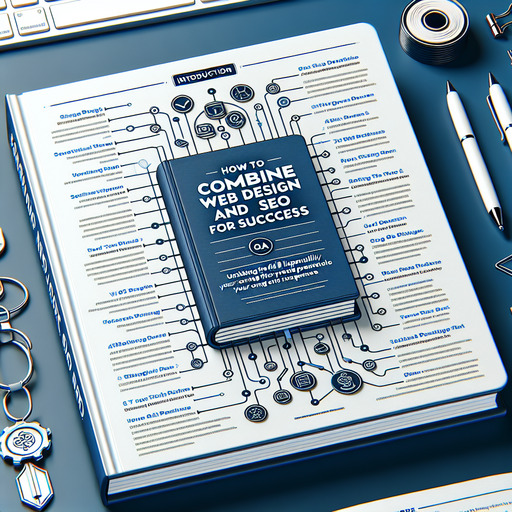
-
Table of Contents
Unlock the full potential of your online presence by mastering the synergy between Web Design and SEO. Discover how to combine them for unparalleled success. Learn More
Introduction
Web design and SEO (Search Engine Optimization) are two critical components of a successful online presence. Web design focuses on the aesthetics, usability, and overall user experience of a website, ensuring it is visually appealing and easy to navigate. SEO, on the other hand, involves optimizing a website to rank higher in search engine results, driving organic traffic and increasing visibility. Combining web design and SEO effectively can lead to a powerful synergy that enhances both user experience and search engine performance. By integrating SEO best practices into the web design process, businesses can create websites that not only attract and retain visitors but also achieve higher search engine rankings, ultimately leading to greater online success.
How to Combine Web Design and SEO for Success: A Comprehensive Guide
Combining web design and SEO is essential for creating a successful online presence. While web design focuses on the aesthetics and usability of a website, SEO (Search Engine Optimization) aims to improve its visibility on search engines. Integrating these two elements can significantly enhance user experience and drive organic traffic. To achieve this, it is crucial to understand how web design and SEO can complement each other.
First and foremost, a well-structured website is fundamental. Search engines prioritize websites that are easy to navigate, as this improves user experience. Therefore, organizing content logically and using a clear hierarchy of headings can make a significant difference. For instance, using H1 tags for main titles and H2 or H3 tags for subheadings helps search engines understand the structure of your content. Additionally, a clean and intuitive navigation menu ensures that users can easily find the information they are looking for, which can reduce bounce rates and increase the time spent on your site.
Moreover, mobile-friendliness is a critical aspect of both web design and SEO. With the increasing use of smartphones, search engines like Google have adopted mobile-first indexing, meaning they predominantly use the mobile version of the content for indexing and ranking. Therefore, ensuring that your website is responsive and provides a seamless experience across all devices is paramount. This includes optimizing images, using flexible grids, and ensuring that buttons and links are easily clickable on smaller screens.
Another important factor is page load speed. Slow-loading websites can frustrate users and lead to higher bounce rates, negatively impacting your SEO rankings. To enhance load speed, consider compressing images, leveraging browser caching, and minimizing the use of heavy scripts. Tools like Google PageSpeed Insights can provide valuable insights and recommendations for improving your website’s performance.
Content is another area where web design and SEO intersect. High-quality, relevant content is essential for engaging users and improving search engine rankings. However, the way this content is presented can also impact its effectiveness. For example, using readable fonts, appropriate text sizes, and sufficient white space can make your content more accessible and enjoyable to read. Additionally, incorporating multimedia elements such as images, videos, and infographics can enrich the user experience and make your content more shareable.
Internal linking is another strategy that can enhance both web design and SEO. By linking related pages within your website, you can help users discover more content and keep them engaged longer. This also helps search engines crawl your site more effectively, improving the overall SEO performance. However, it is important to ensure that these links are relevant and add value to the user experience.
Furthermore, the use of meta tags, including title tags and meta descriptions, plays a crucial role in SEO. These elements provide search engines with information about the content of your pages and can influence click-through rates from search engine results pages. While these tags are not directly visible to users, they should be crafted carefully to be both informative and enticing.
Lastly, user experience (UX) design principles should be integrated with SEO strategies. A positive user experience can lead to higher engagement, more social shares, and better conversion rates. This includes ensuring that your website is accessible to all users, including those with disabilities. Implementing features such as alt text for images, keyboard navigation, and screen reader compatibility can make your website more inclusive and improve its SEO performance.
In conclusion, combining web design and SEO requires a holistic approach that considers both the technical and aesthetic aspects of your website. By focusing on structure, mobile-friendliness, load speed, content presentation, internal linking, meta tags, and user experience, you can create a website that not only looks great but also performs well in search engine rankings. This integrated approach can ultimately lead to greater online success and a more satisfying experience for your users.
Q&A
**Question:** How can web design and SEO be effectively combined for success?
**Answer:** To effectively combine web design and SEO for success, ensure that your website is mobile-friendly, has fast loading times, uses clean and efficient code, includes keyword-optimized content, has a logical and user-friendly navigation structure, utilizes proper heading tags (H1, H2, etc.), incorporates alt text for images, and implements internal linking strategies. Additionally, focus on creating a visually appealing design that enhances user experience while adhering to SEO best practices.